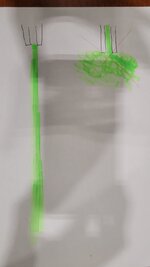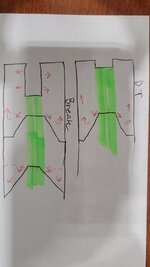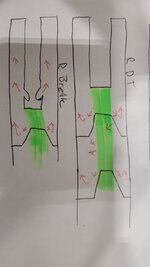HuntInWild88
WKR
Ok I know a couple people wanted me to break down suppressors a little better. I'm more of a visual person so I apologize in advance for the all the pictures(I'm no artist) and more than likely terrible writing skills.
Ok so this started off as a discussion on reflex suppressors(over the barrel(OTB) and traditional style suppressors. They also wanted to break down the difference in direct thread (DT) and mounts with a break.
So the purpose of a suppressor is to down the release of the high pressure gasses when leaving the barrel. Think of it like twiting up a water bottle and flicking the cap off. You get a pop right? Now take another twisted up water bottle and slowly twist the cap off. You just get a hiss or ppssshh sound. The same amount of air is being released its just at a different flow rate. Now how do slow down that high pressure gas?
We can slow down that release impulse by making that gas colum pass through a series of chambers. Seems simple right? Not so much. The gas colum doesn't come out and instantly start expanding. Instead it come out in a linear flow. Think of water leaving a garden house. It stays together until it starts loosing its velocity.
The challenge is to peel the gasses away from the colum. This is done by the baffles inside the suppressor.
So now there comes why a suppressor that has a mount and a break is more effective than a direct thread at slowing down the gas release.

In the picture above the gas flow is green and the red arrows represent gasses that have been removed from the gas colum. The blast chamber(empty space in the suppressor between muzzle and and first baffle) is probably one of the most important features of a suppressor. It normally holds the most volume of space that the gasses can fill. The issue come with trying to get the gasses to fill this space. As you can see with a DT the first thing that gas colum come in contact with is the first baffle. Now depending on the designe of the baffle depends on what the gasses that have been peeled of of the colum do. If you look at the "break" picture you can see I have drawn two different baffle styles. One with a shoulder at the base and one that is just a sharp at the base. The one with the shoulders goal is to help give the gasses room to make a Uturn. Actully getting the gasses to make that uturn is not easy considering the spead it traveling. The issue with the sharp corner is the gasses get trapped( represent by the dotted lines) the trapped gas creates a bubble which now takes up real-estate inside that chamber. We don't want that. We need as much usable volume as possible. In the drawing with the break you can see the break helps fill the blast chamber more efficiently than a direct thread.
Hope yall are still with me.
Now reflex design(OTB). There are pro's and cons to this design. See photo below.
The OTB design helps with the volume of the blast chamber(BC) the issue once again is trying to effectively fill that large of a BC. With a direct thread it's already hard enough to get the gasses to do that UTurn now your asking them not only do the UTurn but to travel a greater distance backwards. Where that is literally what a break is designed to do.
Now because the purpose of a reflex is to create a larger volume OTB. It really only makes sense to use the smallest profile barrel. If you use a bull barrel you are robbing your self of BC volume.
The other reason people use reflex is to get a larger volume suppressor without having it stick so far off the end of your barrel. The issue I have with this is larger volume=more material=more weight.
Now I have a 10" reflex and a 7.5" normal. The reflex is 24oz the 7.5 is 14oz. Mounted the 7.5 comes out at .5" longer overall length.
In a hunting situation I can't tell the difference in sound between the 10" and 7.5"
Ok so this started off as a discussion on reflex suppressors(over the barrel(OTB) and traditional style suppressors. They also wanted to break down the difference in direct thread (DT) and mounts with a break.
So the purpose of a suppressor is to down the release of the high pressure gasses when leaving the barrel. Think of it like twiting up a water bottle and flicking the cap off. You get a pop right? Now take another twisted up water bottle and slowly twist the cap off. You just get a hiss or ppssshh sound. The same amount of air is being released its just at a different flow rate. Now how do slow down that high pressure gas?
We can slow down that release impulse by making that gas colum pass through a series of chambers. Seems simple right? Not so much. The gas colum doesn't come out and instantly start expanding. Instead it come out in a linear flow. Think of water leaving a garden house. It stays together until it starts loosing its velocity.

The challenge is to peel the gasses away from the colum. This is done by the baffles inside the suppressor.
So now there comes why a suppressor that has a mount and a break is more effective than a direct thread at slowing down the gas release.

In the picture above the gas flow is green and the red arrows represent gasses that have been removed from the gas colum. The blast chamber(empty space in the suppressor between muzzle and and first baffle) is probably one of the most important features of a suppressor. It normally holds the most volume of space that the gasses can fill. The issue come with trying to get the gasses to fill this space. As you can see with a DT the first thing that gas colum come in contact with is the first baffle. Now depending on the designe of the baffle depends on what the gasses that have been peeled of of the colum do. If you look at the "break" picture you can see I have drawn two different baffle styles. One with a shoulder at the base and one that is just a sharp at the base. The one with the shoulders goal is to help give the gasses room to make a Uturn. Actully getting the gasses to make that uturn is not easy considering the spead it traveling. The issue with the sharp corner is the gasses get trapped( represent by the dotted lines) the trapped gas creates a bubble which now takes up real-estate inside that chamber. We don't want that. We need as much usable volume as possible. In the drawing with the break you can see the break helps fill the blast chamber more efficiently than a direct thread.
Hope yall are still with me.
Now reflex design(OTB). There are pro's and cons to this design. See photo below.

The OTB design helps with the volume of the blast chamber(BC) the issue once again is trying to effectively fill that large of a BC. With a direct thread it's already hard enough to get the gasses to do that UTurn now your asking them not only do the UTurn but to travel a greater distance backwards. Where that is literally what a break is designed to do.
Now because the purpose of a reflex is to create a larger volume OTB. It really only makes sense to use the smallest profile barrel. If you use a bull barrel you are robbing your self of BC volume.
The other reason people use reflex is to get a larger volume suppressor without having it stick so far off the end of your barrel. The issue I have with this is larger volume=more material=more weight.
Now I have a 10" reflex and a 7.5" normal. The reflex is 24oz the 7.5 is 14oz. Mounted the 7.5 comes out at .5" longer overall length.
In a hunting situation I can't tell the difference in sound between the 10" and 7.5"
